
“Haben wir etwas falsch gemacht?” – Well… according to this alternative, there are better options to Google Chrome.
[via]

“Haben wir etwas falsch gemacht?” – Well… according to this alternative, there are better options to Google Chrome.
[via]
On to the last part of my extended Nokia E71 review!

It feels like there’s so much more to mention on this phone, especially if you regard it as your electronic workhose that not only has to deliver basic office functionality, but also manage your business and private life.
What I can tell so far is that it is a very valid candidate that could send my N95 into early retirement. IF only the camera was better on the E71, I’d immediately switch and try to find a cheap contract online that subsidizes the E71. But it isn’t. The camera module (& it’s Carl Zeiss lenses) is the No. 1 reason why I’ll keep my N95 for the time being and maybe switch to an N79 one day or, even better, wait for the upcoming E72 & E75 models.
If I was still stuck with my old Nokia 6230i though and wasn’t spoiled by the multimedia capabilities of the N95 (e.g. video editor on board), I’d probably take the E71 right on. Again, if you’re interested in taking photos in darker surroundings (~ in a restaurant for a business dinner), there are other, better camera phones than the E71. As for the Nokia range of phones, I’d recommend those with a Xenon flash anyways.
So what about the “business & private life” issue?
…taking this snapshot of “Computer Loban Dhoop” (eerrrr…?) & testing the camera on the E71, I had come across this beautiful view:

I didn’t know that my old friend Garen is actually pursuing a career in Asia. :-)
The Nokia N95 has been on the market for quite some time now (March 2007?) and if there’s anything I always wanted to change about it, then it clearly is the inappropriate headset it came shipped with (pictured below).

The HS-45 headset with its AD-43 remote control unit failed to work after 4-5 months in use, so I went out and bought a few ofter solutions that never really performed the way I wanted it. Also, Nokia never really delivered a better solution, but instead kept on producing other unsatifying headsets.
While reviewing the Nokia E71 business phone that came shipped with the HS-47 headset as well as the state-of-the-art BH-903 Bluetooth Stereo Headset (for review), I quickly realized that I would want to have something similar to the HS-47.
What I needed to do was to merge my Sony MDR-818 earphones with the HS-43 headset I had bought via eBay some time ago. After all, what I need in a working wired headset are the following features:
So there I went, cutting the 10,- EUR Sony earphones into pieces and opening up the control unit on the HS-43…
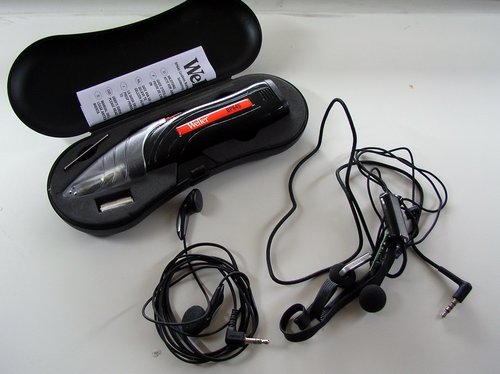
some of the tools: a soldering iron (maybe not this Weller as it takes ages to heat up), old Sony MDR-818 earphones, Nokia HS-43 headset
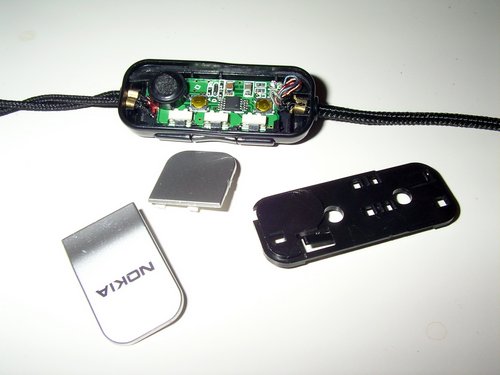
HS-43 control unit opened up
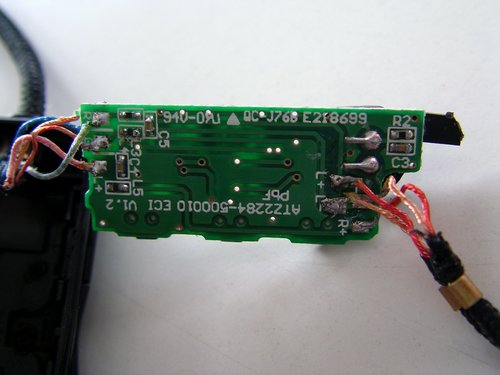
unsolder L+ / L- and R+ / R- to remove the existing earphones + also remove the brass clip on the cable

trim the “new” earphones to the desired length and solder them onto the PCB, refix the brass clip to provide a strain relief on the cable (important!)
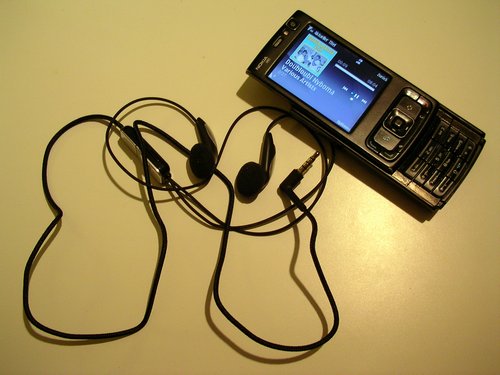
Et voilá – JKE’s own headset for the N95 that fulfills all the open issues I ever had with other headsets. Nice!
@ Nokia: PLEASE change your headset policy and – if you don’t want to equip your shipped handsets with decent headsets due to marketing reasons – at least provide us with better alternatives. Headsets are a commodity, and will as such always brake at one point.
The Nokia E71 (business) phone I received from WomWorld/Nokia earlier this week also came shipped with an extra goodie: the Nokia BH-903 Bluetooth headset.
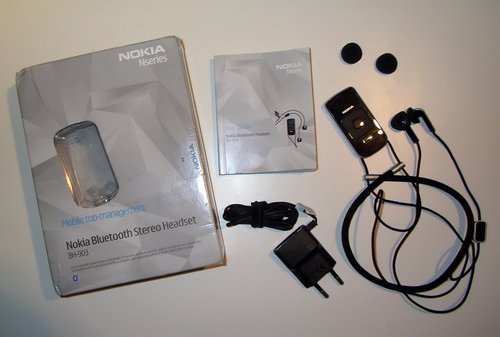
Nokia Bluetooth Stereo Headset BH-903: box, manual, charger, headset, earphone foam covers
As you can already see from the packaging, it’s meant to be part of the Nseries. N, as in eNtertainment. And that’s what it’s all about: adding value to your mobile audio entertainment.
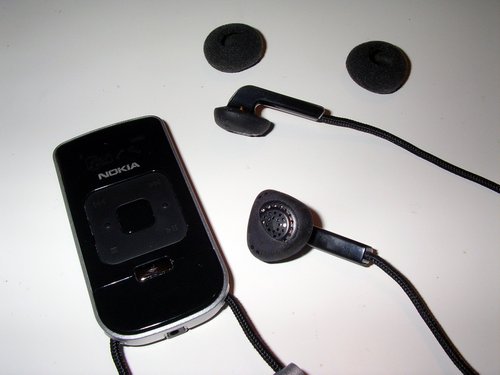
The Nokia E71 Eseries phone does not really need an additional headset as it already comes with an adequate headset, the HS-47. So why would you want to add a high quality multimedia device to a business phone?
Because you can.
That is, if you’re already able to spend the proud sum of EUR 360,- on a business phone (E71), you may just as well be able to cough up another EUR 130,- for a true Bluetooth stereo headset that comes with up to 11h of playtime (150h standby), 32g weight, quick charge capability within 45 minutes, an extra radio, accepts the same charger as the E71 and offers different Bluetooth 2.0 profiles.
As mentioned in the previous part of this extended review, the E71-1 has a relatively high specific absorption rate (SAR) of 1,33 W/kg, with the antenna located at the bottom of the device. That’s why the use of an external headset makes sense to those who are afraid of any additional electromagnetic fields (Bluetooth = max 100mW, Rx/Tx unit is located inside the control unit and not on the earphones next to your ears).
And then of course you may want to have your hands free for other stuff: holding the phone onto your ears during longer conversations is just very annoying.
“OK – sounds like a good reason”, you may reply, “…but why can’t I just use the simple HS-47 headset that came shipped with the E71? And why not another, cheaper Bluetooth headset capable of the A2DP profile? Also, my company will prolly never pay for the extra headset….”
Four reasons why the BH-903 may just be what you’ve been looking for!
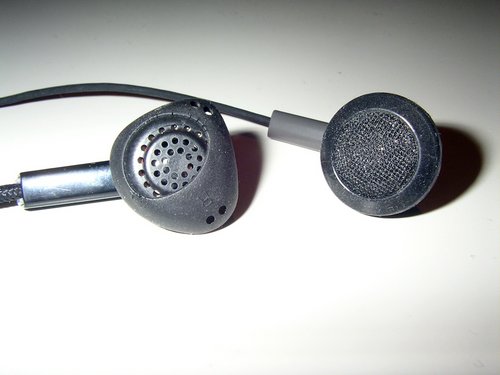
earphones on the BH-903 vs. HS-47
1. the shape of the earphones
What you see in the picture above are the earphones from (left) BH-903 and (right) HS-47. Can you spot the difference?
First, both devices may cover different frequency spectrums, but to most users, this dynamic range isn’t really important (as our hearing ability deteriorates with age, etc.). So, despite of such technical blabla, what do you see on the picture?
Right! There’s a special rubber around the (left) BH-903 earphone which makes it easier to fit these earphones into your ears and sit a bit tigther than the simple round ones.
I am using simple Sony MDR-E 818 LP on my N95 for this very reason, as these cheap EUR 10,- Sony earphones provide a similar comfort – even though they are just earphones, not a headset (no mic, no remote control unit, etc.).
As mentioned earlier, this difference is a BIG issue to ppl like me. If you’re as tall as I am (6’4″ // 1,92m), simple round earphones will at one point fall out of your ears and really spoil your mobile audio entertainment. So-called “in-ear” headphones (which apparently became popular with SonyEricsson phones) may be a solution to that, but when it comes to the old-fashioned/conventional earphones, a special rubber casing like the one above on the BH-903 headset makes a lot of sense.
Try it and you’ll spot the difference.
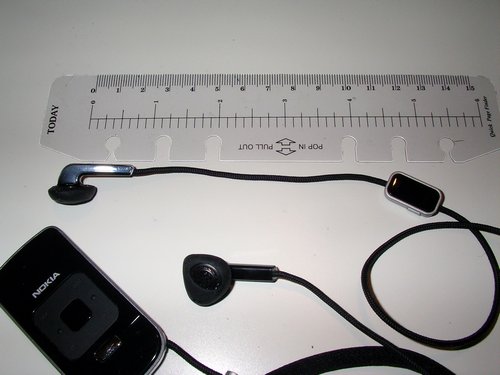
BH-903 remote control unit & earphones
2. distance betwen the left earphone and the microphone
The microphone is located on a small control unit, approx. 12cm away from the left right earphone. This control unit also contains a mute key on the side and an answer/end key on the front.
As opposed to other, previous Nokia headsets, Nokia really learned and improved their headsets by moving the microphone up from a position located on the chest to one at the height of the mouth – where it’s supposed to be. Have you ever seen ppl holding the microphone close to their mouth while talking handsfree on a mobile? Now that’s exactly why: because their microphone isn’t where it’s supposed to be. In a noisy environment (commuter train, downtown, etc.), this really is an issue – so with the mic now being closer to your mouth, you won’t need to hold it in your hands.
This is actually one of those reasons why I’ve always envied my SonyEricsson K800i friends who just had the better headset…
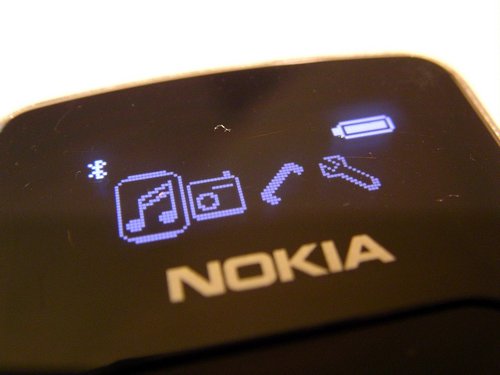
OLED (organic light emitting diode) menu display on the BH-903 headset: music playback, radio, telephone, settings; top row: Bluetooth + Battery charge indicators
3. Bluetooth 2.0 + EDR profiles
In short: Bluetooth is the wireless standard for short range radio connections between mobile phones, headsets, PDAs, laptops, etc; and profiles are different services that are added to a Bluetooth device. So for every wireless action (listening to music via the headset, sending the phonebook to the headset or to your car’s navi system, etc.) all Bluetooth devices need to support these profiles – but not all BT devices actually do that.
You wouldn’t really need a display on an external headset if it wasn’t for the extra options it has to offer. The terrific OLED display does not only inform you about the current radio station, but it also provides information on the following options:
(a) Phone Book Access Profile (PBAP): choose a number to dial right from the remote control via the menu without even removing the phone from your pocket. Nice!
(b) Advanced Audio Distribution Profile (A2DP): if you own a A2DP-capable phone (like the E71 or the N95), this means you can listen to the music from the phone on the headset.
(c) Audio Video Remote Control Profile (AVRCP): If your mp3 collection on the phone is ID3 tagged, you’ll will be able to read the filenames/ID3 tags of the currently played track on the display.
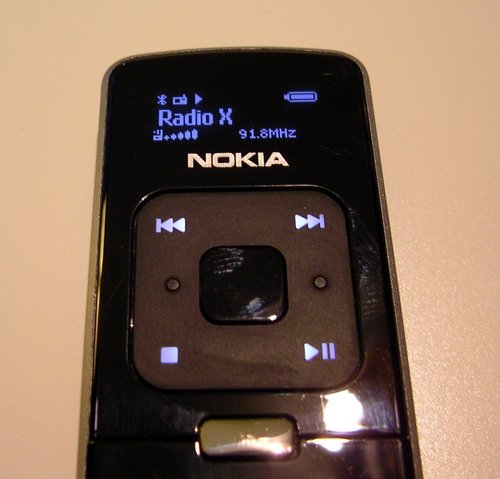
Frankfurt’s only good radio station “Radio X” via the BH-903
4. iPod touchpad
Yep, to raise the volume, just move your fingers clockwise on the touchpad. Don’t we already know this kind of volume control from the iPods and current Nokia (Nseries) phones? Neat!
—
Verdict:
Four plausible reasons why the BH-903 isn’t just another headset out of the many, many you can get for your phone from authorized retailers as well as from eBay China & Co..
130,- EUR are a lot of money for such a device, but if you’re really serious about wireless stereo audio entertainment on Nokia phones, you’ll probably quickly realize that there aren’t so many alternatives on the market. An alternative may be the SonyEricsson HBH-DS-970 headset although some folks complain that it isn’t really 100% compatible to the Nokia range of phones. Also, there are other – cheaper – Bluetooth headsets from Nokia that also just do the job. The BH-903 though (which, as far as I am informed, also is the most expensive one) does this job extremely good and provides the necessary information through a smart OLED display at the right location (hanging on your neck – and not somewhere on your ears).
I, the N95 user, am actually still looking for a decent & wired headset compatible with the N95 (angled 3,5mm jack without any special adapters, shaped earphones, mic close to the mouth) and have tested and bought three different headsets for my N95 from Nokia when the one that came shipped with the N95 failed after 4-5 months in use (due to a cheap battery inside the remote control unit).
I wonder why Nokia produces so many different headsets and doesnt keep them on the market for long. Why can’t they just produce one good wired and one good wireless solution? The BH-903 is one of those “(very) good wireless” solutions, but for wired headsets, a simple headset like the HS-43 should come with better earphones. Also, a headset shouldn’t be that expensive, at least not those that come with in-ear /earphones. Take the BH-903 earphones, add another 3,5mm jack and I’m your next customer. I’d be willing to pay up to 49,- EUR for such a solution.
P.S.: More images from the BH-903 on my flickr set.

Obviously, one of those WTH? moments.
…
AOB: How-to-tease-your-wife-with-LOTs-of-noise a.k.a. “Bicycle Propelling Aid Fricycle”.
Fricycle. The Chinese. Lovely.
The E71 is a business phone.
Having said that, it is also suited for those users who actually have to cough up some savings and are looking for a decent mobile workhorse. As opposed to an iPhone (no tactile feedback) or another QWERTY-equipped Windows Mobile phone, the E71 comes with the perfect mixture of (a) usability, (b) design, (c) built quality and (d) connectivity.
However, it still has some flaws that need to be mentioned here and may partly be changed by upcoming firmware upgrades.
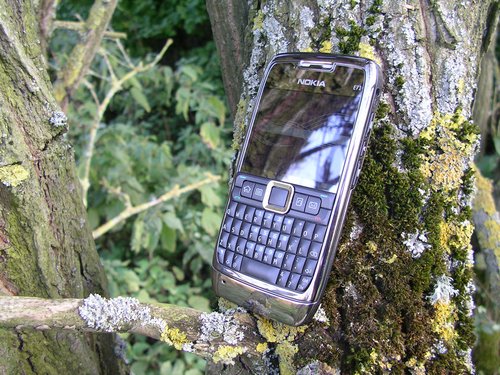
Coming from a Nokia N95, I am of course already spoiled in terms of multimedia functionality. And this although I am one of those users who prefer the business functions over to the multimedia capability. I primarily use my N95 for reading e-mails on the train, listening to some music and taking a few snapshots from time to time (even in macro mode, which is quite decent on the N95). Reasons enough to allow a direct comparison of the E71 with my N95. But mind you – the following observations aren’t meant to be a comparison alone!
Continue reading “JKE’s Nokia E71 review: (4) the fine print”